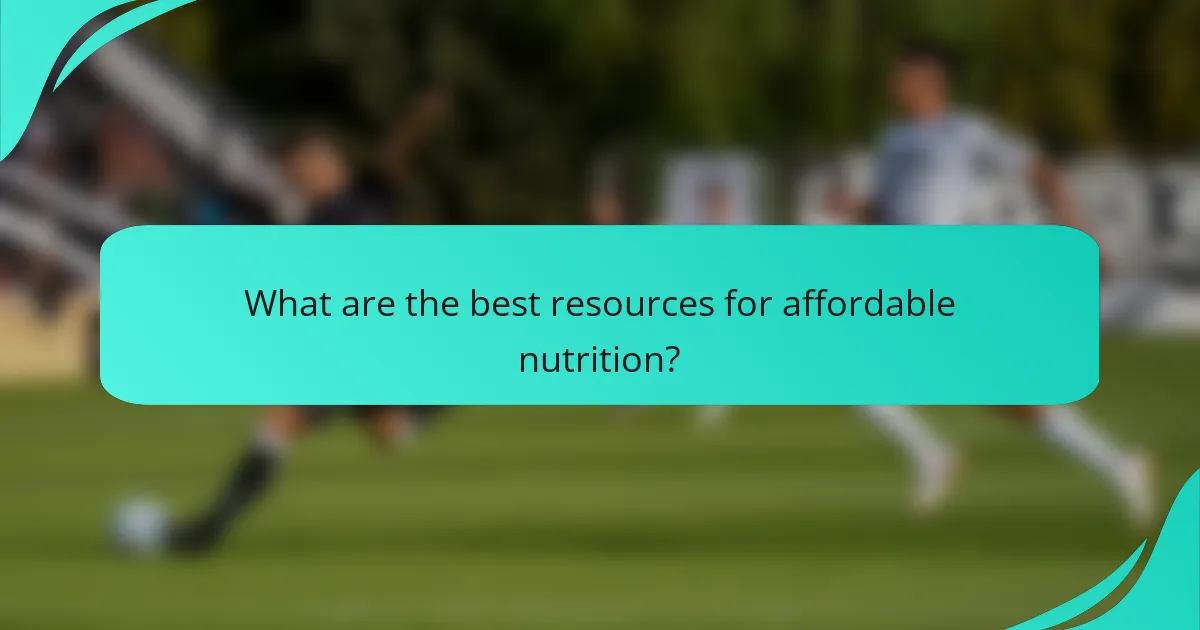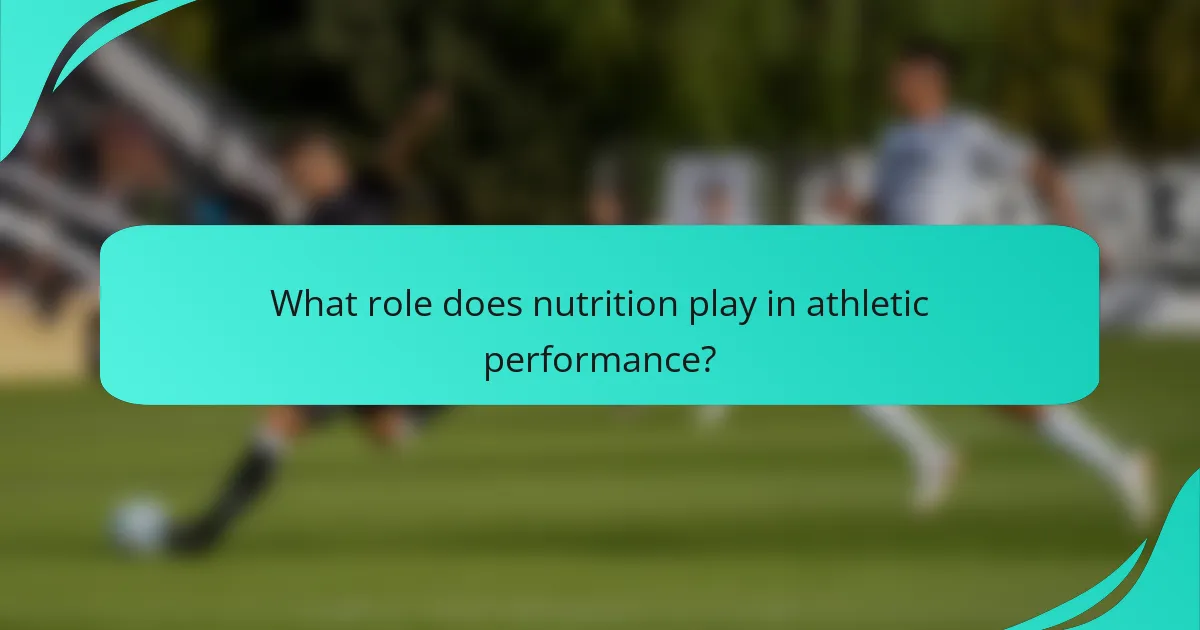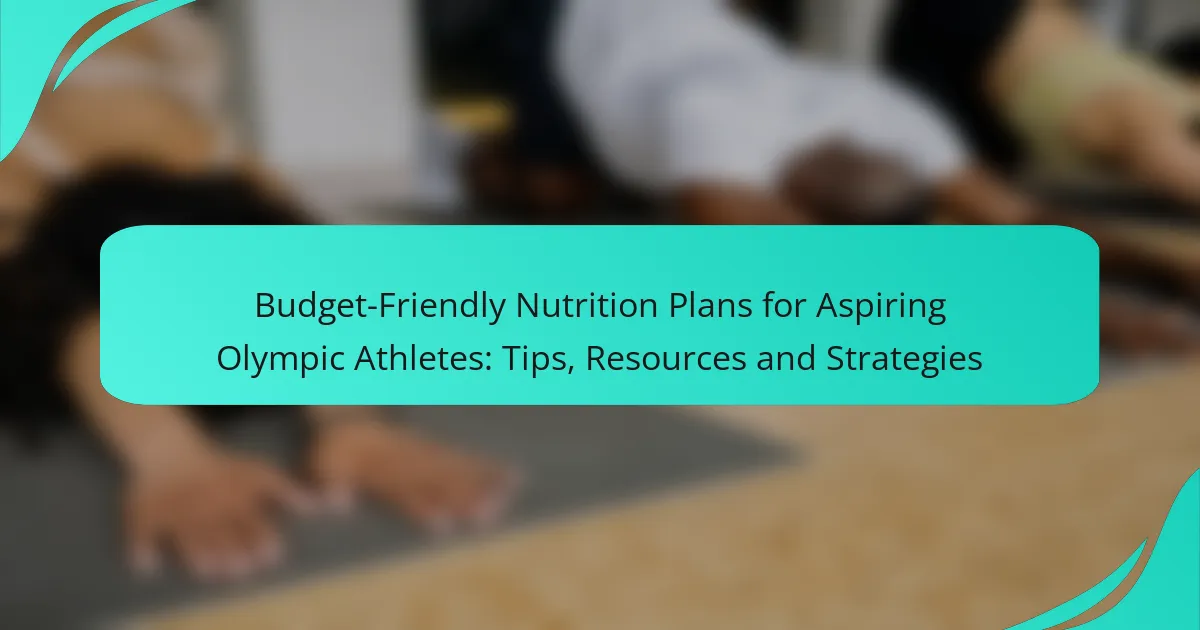For aspiring Olympic athletes, maintaining a nutritious diet on a budget is essential for both performance and financial sustainability. By focusing on whole foods, strategic shopping, and meal preparation, athletes can meet their dietary needs without overspending. Leveraging resources like online tools and community support can further enhance their nutrition plans while keeping costs manageable.

What are budget-friendly nutrition plans for aspiring Olympic athletes?
Budget-friendly nutrition plans for aspiring Olympic athletes focus on providing essential nutrients while minimizing costs. These plans prioritize whole foods, meal preparation, and strategic shopping to ensure athletes can meet their dietary needs without overspending.
Meal prep strategies
Effective meal prep is key to maintaining a budget-friendly nutrition plan. Start by dedicating a few hours each week to prepare meals in bulk, which can save both time and money. Consider cooking large portions of grains, proteins, and vegetables that can be mixed and matched throughout the week.
Use containers to portion out meals for easy access and to avoid impulse purchases. Labeling containers with dates can help track freshness and ensure you consume meals before they spoil.
Cost-effective food choices
Choosing cost-effective foods is essential for a budget-friendly nutrition plan. Focus on staples like rice, beans, lentils, and seasonal vegetables, which are typically less expensive and provide a good source of nutrients. Frozen fruits and vegetables can also be a budget-friendly alternative, offering convenience without sacrificing quality.
Shopping at local markets or buying in bulk can further reduce costs. Look for sales and discounts on protein sources such as chicken, eggs, and canned fish, which can be incorporated into various meals.
Sample meal plans
A sample meal plan for a budget-conscious athlete might include oatmeal with fruit for breakfast, a quinoa salad with beans and vegetables for lunch, and grilled chicken with sweet potatoes and broccoli for dinner. Snacks could consist of yogurt, nuts, or homemade energy bars.
Another option could be a vegetarian plan featuring smoothies with spinach and bananas, lentil soup with whole grain bread, and stir-fried tofu with mixed vegetables. Adjust portion sizes based on individual energy needs and training intensity.

How can aspiring Olympic athletes save on nutrition costs?
Aspiring Olympic athletes can save on nutrition costs by implementing strategic purchasing habits and making informed food choices. Focusing on bulk buying, seasonal produce, and discount grocery stores can significantly reduce expenses while maintaining a balanced diet.
Buying in bulk
Buying in bulk is an effective way to lower food costs for athletes. Staples like rice, oats, pasta, and legumes often come at a lower price per unit when purchased in larger quantities. Consider investing in a membership at wholesale clubs where bulk items can be found at discounted rates.
When buying in bulk, prioritize non-perishable items that have a long shelf life. This approach not only saves money but also minimizes trips to the store, allowing for more time to focus on training. Just be cautious to avoid over-purchasing perishables that may spoil before they are consumed.
Utilizing seasonal produce
Utilizing seasonal produce can significantly cut down on grocery bills while providing fresh and nutritious options. Fruits and vegetables that are in season are typically more affordable and taste better. For example, in the summer, berries and tomatoes are often cheaper and more flavorful than in the winter months.
To maximize savings, plan meals around seasonal items and consider visiting local farmers’ markets, where prices can be lower than at supermarkets. Additionally, buying in bulk during peak season and freezing excess produce can help maintain a diverse diet throughout the year.
Discount grocery stores
Discount grocery stores offer a variety of products at lower prices, making them a valuable resource for aspiring athletes. Stores like Aldi or Lidl often carry many of the same items as larger chains but at reduced prices. Look for store brands, which can provide significant savings without sacrificing quality.
When shopping at discount stores, check for weekly specials and clearance items to maximize savings. It’s also beneficial to create a shopping list based on sales to avoid impulse buys and ensure that you stick to your budget while still meeting nutritional needs.

What are the best resources for affordable nutrition?
Affordable nutrition resources for aspiring Olympic athletes include various online tools, apps, and community support groups that help manage dietary needs without breaking the bank. Utilizing these resources can streamline meal planning, track nutritional intake, and foster motivation through shared experiences.
Online meal planning tools
Online meal planning tools can simplify the process of creating nutritious and budget-friendly meal plans. Websites like Mealime and Eat This Much allow users to input dietary preferences and budget constraints, generating tailored meal suggestions. These platforms often feature grocery lists, which can help save time and reduce food waste.
When using meal planning tools, consider focusing on seasonal ingredients and bulk purchases to maximize savings. Look for recipes that use similar ingredients to minimize costs while ensuring variety in your meals.
Nutrition apps for tracking
Nutrition tracking apps such as MyFitnessPal and Cronometer enable athletes to monitor their daily food intake and nutritional values. These apps often have extensive databases of foods, making it easier to log meals accurately and stay within budget. Many of them offer free versions with essential features, which can be sufficient for most users.
To make the most of these apps, set specific goals for macronutrients and calories based on your training needs. Regularly reviewing your intake can help identify areas for improvement and ensure you are meeting your nutritional requirements without overspending.
Community support groups
Joining community support groups, either online or in-person, can provide valuable encouragement and shared knowledge for maintaining a budget-friendly nutrition plan. Platforms like Facebook and Reddit host groups focused on nutrition for athletes, where members share tips, recipes, and experiences.
Engaging with these communities can help you discover cost-effective meal ideas and local resources, such as farmers’ markets or food co-ops. Additionally, participating in discussions can motivate you to stay committed to your nutrition goals while learning from others’ successes and challenges.

What are effective strategies for meal planning?
Effective meal planning strategies help aspiring Olympic athletes maintain a balanced diet while managing their budgets. By organizing meals in advance, athletes can ensure they meet their nutritional needs without overspending.
Weekly menu templates
Using weekly menu templates simplifies meal planning by providing a structured approach to food choices. Athletes can create a template that includes breakfast, lunch, dinner, and snacks for each day, focusing on nutrient-dense foods like whole grains, lean proteins, fruits, and vegetables.
For example, a basic template might include oatmeal with fruit for breakfast, a quinoa salad with grilled chicken for lunch, and baked salmon with steamed broccoli for dinner. This method not only saves time but also reduces food waste by ensuring that all ingredients are used efficiently.
Batch cooking techniques
Batch cooking involves preparing large quantities of food at once, which can be portioned and stored for later use. This technique is particularly beneficial for athletes with busy training schedules, as it allows for quick meal options throughout the week.
To implement batch cooking, select a few recipes that share common ingredients, such as a vegetable stir-fry and a soup. Cook these dishes in bulk, then divide them into individual servings to freeze or refrigerate. This approach can significantly cut down on cooking time and costs.
Portion control methods
Portion control is crucial for athletes to manage their energy intake and maintain optimal performance. By understanding appropriate serving sizes, athletes can avoid overeating while ensuring they consume enough nutrients for recovery and training.
One effective method is to use measuring cups or a food scale to serve meals, particularly for calorie-dense foods like nuts or oils. Additionally, visual cues, such as filling half of a plate with vegetables and a quarter with protein, can help maintain balanced portions without constant measuring.

How do dietary needs differ for Olympic athletes?
Dietary needs for Olympic athletes are significantly higher than those of the average person due to their intense training and performance demands. These athletes require a well-balanced intake of macronutrients, hydration, and sometimes supplements to support their rigorous physical activities and recovery processes.
Macronutrient requirements
Macronutrient needs for Olympic athletes vary based on their sport, training intensity, and individual goals. Generally, a higher carbohydrate intake is essential, often comprising around 55-65% of total daily calories, to fuel endurance and high-intensity workouts. Protein needs are also elevated, typically ranging from 1.2 to 2.0 grams per kilogram of body weight, to support muscle repair and growth.
Fats should not be neglected, making up about 20-35% of total caloric intake, focusing on healthy sources like avocados, nuts, and olive oil. Athletes should tailor their macronutrient ratios based on their specific training cycles and performance objectives.
Hydration strategies
Proper hydration is crucial for Olympic athletes to maintain peak performance and prevent dehydration. Athletes should aim to drink fluids regularly throughout the day, with specific attention to pre-, during, and post-exercise hydration. A general guideline is to consume about 500-700 mL of water or electrolyte drinks in the hours leading up to training.
During exercise, especially in hot conditions, athletes may need to drink 200-300 mL every 15-20 minutes. Post-exercise, rehydration is vital; consuming fluids along with electrolytes can help restore balance and support recovery.
Supplement considerations
While a well-rounded diet should provide most nutrients, some Olympic athletes may consider supplements to enhance performance or recovery. Common supplements include protein powders, creatine, and branched-chain amino acids (BCAAs). It’s essential to consult with a sports nutritionist to determine if supplementation is necessary and to avoid any banned substances.
Additionally, athletes should be cautious about the quality and sourcing of supplements, as not all products are regulated. Choosing third-party tested supplements can help ensure safety and efficacy.

What role does nutrition play in athletic performance?
Nutrition is crucial for athletic performance as it directly influences energy levels, recovery, and overall physical capabilities. Proper dietary choices can enhance endurance, strength, and mental focus, which are essential for aspiring Olympic athletes.
Energy levels
Energy levels are significantly impacted by nutrition, as the body requires fuel to perform at its best. Athletes should focus on a balanced intake of carbohydrates, proteins, and fats to sustain energy throughout training and competition. For instance, complex carbohydrates like whole grains and fruits provide long-lasting energy, while proteins support muscle repair.
A general guideline for athletes is to consume about 55-65% of their total daily calories from carbohydrates, especially before intense workouts. This helps maintain optimal energy levels and prevents fatigue during training sessions.
Recovery times
Nutrition plays a vital role in recovery times, as the right nutrients can speed up the healing process and reduce muscle soreness. Consuming a combination of protein and carbohydrates within 30 minutes post-exercise is ideal for replenishing glycogen stores and repairing muscle tissue. Foods like yogurt with fruit or a protein shake can be effective choices.
Aim for a recovery meal that includes approximately 20-30 grams of protein and a similar amount of carbohydrates. Staying hydrated is equally important, as proper fluid intake aids in recovery and overall performance. Athletes should monitor their hydration levels, especially after intense training sessions, to ensure optimal recovery.
